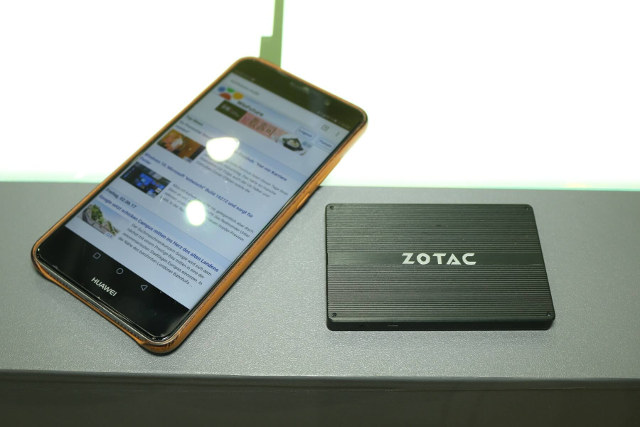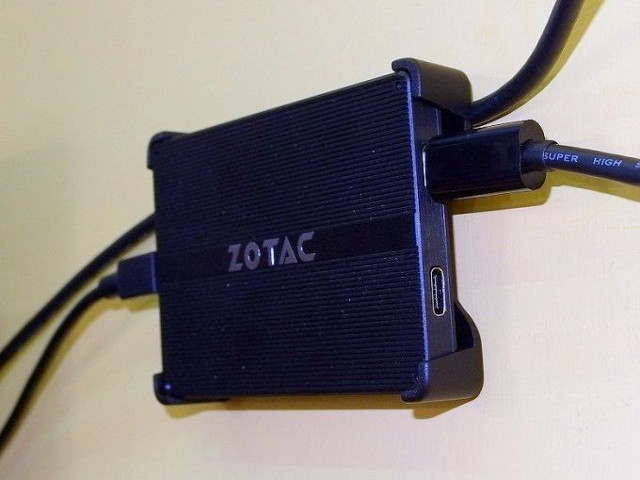We’ve covered a large number of tiny mini PCs and TV sticks powered by Intel processors, but usually they are thicker than your smartphone because of USB, HDMI, and Ethernet ports if the latter is included. Zotac decided to leverage USB type C data and display capabilities to do away with USB & HDMI ports, and used a micro USB port for power in their latest Zotac PI225 mini PC resulting in an ultra thin (8mm) mini PC that is smaller than a 2.5″ SSD.
Zotac PI225 mini PC specifications:
- SoC – Intel Celeron N3350 dual core “Apollo Lake” processor @ 1.1 / 2.4 GHz with 12 EU Intel HD Graphics 500 (6W TDP)
- System Memory – 4 GB LPDDR3
- Storage – 32 GB eMMC flash, micro SDXC slot
- USB – 2x USB 3.0 type C connectors with data and DisplayPort support
- Connectivity – 802.11ac WiFi and Bluetooth 4.2
- Power – 1x micro USB port
- Dimensions – 90 x 60 x 8 mm

The mini PC should run Windows 10 64-bit. We do not have pricing nor availability information at this stage.
Via Liliputing, Tom’s Hardware, and WinFuture (in German)

Jean-Luc started CNX Software in 2010 as a part-time endeavor, before quitting his job as a software engineering manager, and starting to write daily news, and reviews full time later in 2011.
Support CNX Software! Donate via cryptocurrencies, become a Patron on Patreon, or purchase goods on Amazon or Aliexpress. We also use affiliate links in articles to earn commissions if you make a purchase after clicking on those links.






i’d have to agree smartphones are thick as in brick
was thinking, a raspi3phone anyone?
Does it run linux?
What’s the point? Now you need an external kludge if adapters.
@zoobab
My question too…
And my))
@Occam
Maybe for headless system is might be possible, or – if they exists – for monitors with a built-in USB C dock.
I’m surprised they used a micro USB port for power instead of a USB C port, although it could be to prevent people getting confused…
What would be great (if it is possible, I’m not an electronics engineer) would be to see devices like these start to have universal USB-C plugins where each one could be used for any of the reasons USB-C could be used for the device, i.e. imagine three (3) USB-C ports any of which could be used for any of 1.) powering the device, 2.) providing video out, and 3.) supporting (imagine this!) other devices using USB connectivity. 🙂
@Mike Schinkel
I think the problem is cost, and capabilities of the SoC. Actually, my point about confusion while using 3 USB-C ports would not be so valid, IF companies would just start using the logos specific to power, DisplayPort… near the USB-C ports.
@Mike Schinkel
I would be surprised if this device does not allow to be powered through USB-C (even if the device does not implement recent USB Power delivery specs — higher voltages and negotiation between devices — it should support the 2 USB-C power modes remaining at 5V and providing either 1.5A or 3.0A –> 15W).
Micro USB as can be seen here is somewhat insane (since rated for 9W max) but since currently just a few displays fully support USB-C (only some ‘Apple influenced’ LG screens and one HP AFAIK) providing another DC-IN port might still be mandatory. I would believe it will happen as usual and Apple (or their customers by buying adapters now no one needs in a few years any more) force adoption of this new technology so the rest of us users can benefit from in maybe 3-5 years.
Besides that I don’t understand the interest in this design since according to Winfuture.de it runs hot (whole enclosure is used for heat dissipation), no one knows about Wi-Fi reception yet and maybe it will be sold for digital signage (B2B) only if it’s not just a PoC.
I was wrong before (comment not visible yet for whatever reasons) and there are a few more displays available with full USB-C support (providing power to a connected USB-C host and containing some sort of Dock functionality inside). The LG Thunderbolt 3 displays aren’t an option (since too expensive and resolution too high — with USB-C maximum native resolution is 2560×1440 pixel) but Acer H277HU, HP S240UJ and Philips 258B6QUEB look all like nice companions to such an USB-C device like the Zotac.
I asked a friend with which ‘display docks’ they came up for a bunch of 12″ MacBook they ordered two years ago (that’s the one with just a single USB-C for everything) and he just replied they would be happy now with the HP S240UJ using macOS’ HiDPI modes.
I’m just wondering who is regulating or standardizing “display over USB C”, Intel’s thunderbolt over Type C is one of them, then what about others?
@DX
Citing wikipedia: On 22 September 2014, VESA published the DisplayPort Alternate Mode on USB Type-C Connector Standard.
Thunderbolt is (and was since 2011) something different since due to active cables, higher signal rates in the meantime and greater flexibility both higher resolutions as well as more displays at the same time are possible.